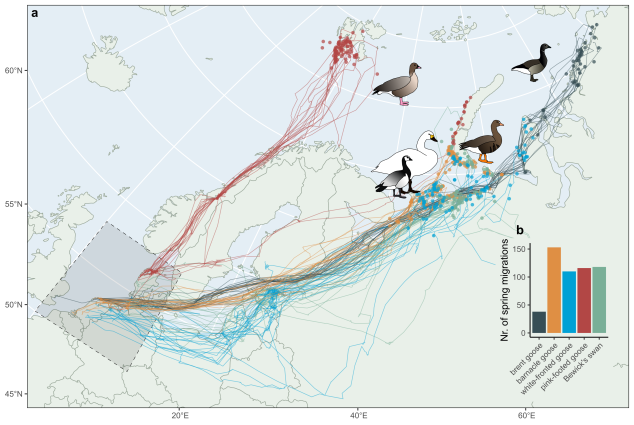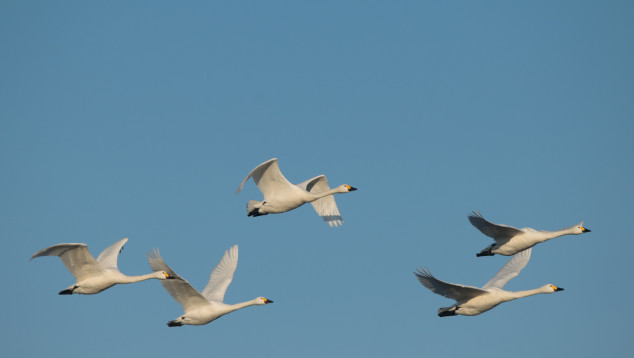Arctic-bound birds can still keep up with climate change – for now

Arctic-bound birds can still keep up with climate change – for now
Press inquiries
As climate change drives earlier spring conditions in the Arctic, birds species that travel there to breed there are under pressure to migrate faster. A new study led by researchers from the University of Amsterdam and the Netherlands Institute of Ecology reveals that many Arctic-breeding waterfowl still have some flexibility when it comes to speeding up their migrations. However, this strategy may only work for a limited time.
The study, published on 9 September 2025 in Nature Climate Change, GPS-tracked over 500 spring migrations of five large waterfowl species: brent geese, barnacle geese, greater white-fronted geese, pink-footed geese and Bewick’s swans. Combining the tracking data with long-term body mass data collected from birds in their wintering grounds, the researchers discovered that these birds can reduce the time spent fuelling for their journey, allowing them to arrive earlier in the Arctic.
‘Our results are both encouraging and concerning,’ said lead author Hans Linssen. ‘We show that these birds can migrate faster by adjusting their stopovers and feeding times. But the clock is ticking if we look at the current rates of Arctic warming - this flexibility will only compensate for the advancing Arctic spring for a few more decades.’
Making up for lost time
To reach their Arctic breeding grounds, the birds must cover thousands of kilometres each spring. Most of the journey isn’t spent flying, but stopping to rest and refuel. The team found that by shortening these fuelling periods the birds could cut their travelling times significantly.
Unlike previous studies, this research also included the fuelling time before the migrations even begin. This pre-departure fuelling was especially important for species like the barnacle and brent geese, which rely heavily on energy stores built up before leaving.
In fact, once this pre-departure phase was factored in, it became clear that the birds had more wiggle room to speed up migrations than previously thought. Some individuals were able to shorten their total fuelling time by up to 30%, shortening their migration by several dozens of days compared to previous years.
Responding to climate signals
The team also found that birds are flexible in how they respond to changing spring conditions. In years when the Arctic thawed early, species like the white-fronted goose and Bewick’s swan reduced stopover times and arrived sooner. But not all birds were equally responsive - pink-footed and brent geese showed less ability to adjust en route, possibly because they have fewer stopover sites.
‘Birds with more stopovers and shorter flights in between could better track spring conditions,’ says Linssen. ‘Those flying longer stretches or across the sea might have less opportunity to react to spring being early or late.’
Adaptability deadline
Despite these adaptations, the researchers warn that speeding up migrations has natural limits. Fuelling more quickly requires high-quality food and favourable conditions, such as low levels of disturbance, which may not always be available. And there’s concern that birds speeding up their migration may pay the price by arriving in worse physical condition, which could affect breeding success.
Based on current climate trends and snowmelt data, the team estimates that the observed flexibility in migration timing could help the birds keep pace with spring for another 18 to 28 years. After that, faster migration alone won’t be enough.
‘These birds are showing remarkable adaptability,’ says Linssen. ‘But by mid-century, they may need to rely on other strategies - like shifting their wintering grounds or changing migration routes entirely - to avoid falling out of sync with the Arctic spring.’
Timing determines success or failure
For migratory birds, reaching the Arctic on time is crucial for their breeding success and survival. When spring arrives and the snow begins to melt, there is an explosion of insects, plants, and other food sources. This peak lasts only a few weeks. If the birds arrive too late, they miss the moment when food is abundantly available to raise their chicks. In addition, there is only a narrow time window in which eggs can be laid, incubated, and the young fed before the cold returns. Any delay can mean that the chicks will not survive the southward migration.
Publication details
Scope for waterfowl to speed up migration to a warming Arctic. Hans Linssen, Thomas Lameris, Michiel Boom, Rascha Nuijten, Nelleke Buitendijk, Adriaan Dokter, Barwolt Ebbinge, Götz Eichhorn, Jan Geisler, Trinus Haitjema, Andrea Kölzsch, Helmut Kruckenberg, Jutta Leyrer, Jesper Madsen, Carl Mitchell, Sander Moonen, Gerhard Müskens, Kees Schreven, Lisa Vergin, Tom Versluijs, Judy Shamoun-Baranes, Emiel van Loon, Bart Nolet: in: Nature Climate Change (9 September 2025). Doi: 10.1038/s41558-025-02419-6


